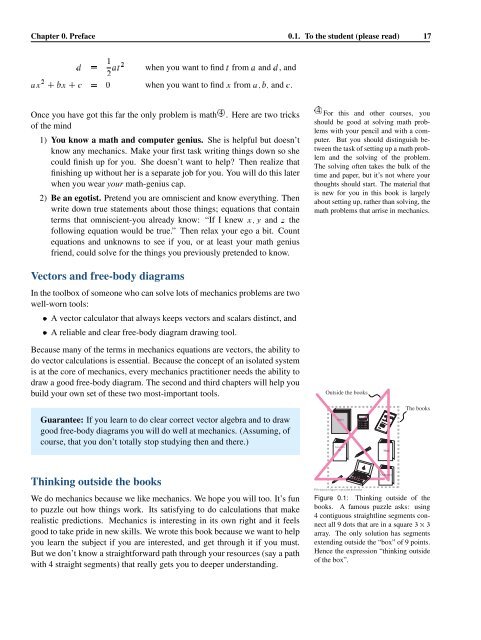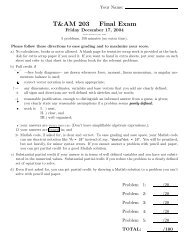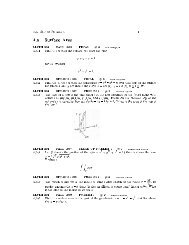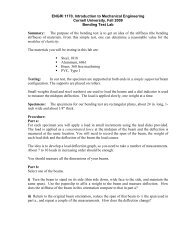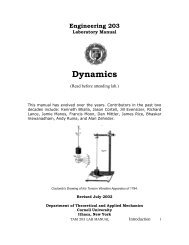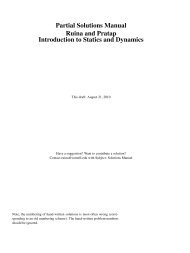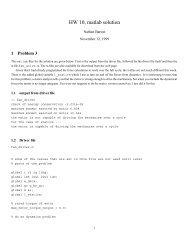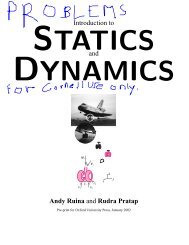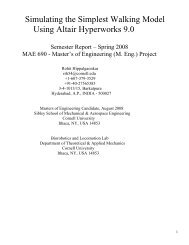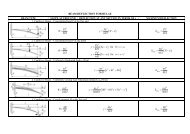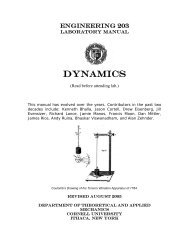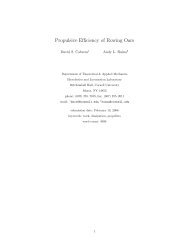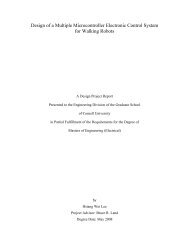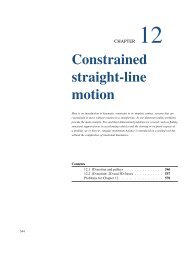Introduction to and Andy Ruina and Rudra Pratap
Introduction to and Andy Ruina and Rudra Pratap
Introduction to and Andy Ruina and Rudra Pratap
You also want an ePaper? Increase the reach of your titles
YUMPU automatically turns print PDFs into web optimized ePapers that Google loves.
Backspace CE C<br />
Chapter 0. Preface 0.1. To the student (please read) 17<br />
d D 1 2 at 2 when you want <strong>to</strong> find t from a <strong>and</strong> d, <strong>and</strong><br />
ax 2 C bx C c D 0 when you want <strong>to</strong> find x from a; b; <strong>and</strong> c.<br />
Once you have got this far the only problem is math 4 . Here are two tricks<br />
of the mind<br />
1) You know a math <strong>and</strong> computer genius. She is helpful but doesn’t<br />
know any mechanics. Make your first task writing things down so she<br />
could finish up for you. She doesn’t want <strong>to</strong> help Then realize that<br />
finishing up without her is a separate job for you. You will do this later<br />
when you wear your math-genius cap.<br />
2) Be an egotist. Pretend you are omniscient <strong>and</strong> know everything. Then<br />
write down true statements about those things; equations that contain<br />
terms that omniscient-you already know: “If I knew x; y <strong>and</strong> z the<br />
following equation would be true.” Then relax your ego a bit. Count<br />
equations <strong>and</strong> unknowns <strong>to</strong> see if you, or at least your math genius<br />
friend, could solve for the things you previously pretended <strong>to</strong> know.<br />
4 For this <strong>and</strong> other courses, you<br />
should be good at solving math problems<br />
with your pencil <strong>and</strong> with a computer.<br />
But you should distinguish between<br />
the task of setting up a math problem<br />
<strong>and</strong> the solving of the problem.<br />
The solving often takes the bulk of the<br />
time <strong>and</strong> paper, but it’s not where your<br />
thoughts should start. The material that<br />
is new for you in this book is largely<br />
about setting up, rather than solving, the<br />
math problems that arrise in mechanics.<br />
Vec<strong>to</strong>rs <strong>and</strong> free-body diagrams<br />
In the <strong>to</strong>olbox of someone who can solve lots of mechanics problems are two<br />
well-worn <strong>to</strong>ols:<br />
A vec<strong>to</strong>r calcula<strong>to</strong>r that always keeps vec<strong>to</strong>rs <strong>and</strong> scalars distinct, <strong>and</strong><br />
A reliable <strong>and</strong> clear free-body diagram drawing <strong>to</strong>ol.<br />
Because many of the terms in mechanics equations are vec<strong>to</strong>rs, the ability <strong>to</strong><br />
do vec<strong>to</strong>r calculations is essential. Because the concept of an isolated system<br />
is at the core of mechanics, every mechanics practitioner needs the ability <strong>to</strong><br />
draw a good free-body diagram. The second <strong>and</strong> third chapters will help you<br />
build your own set of these two most-important <strong>to</strong>ols.<br />
Outside the books<br />
Guarantee: If you learn <strong>to</strong> do clear correct vec<strong>to</strong>r algebra <strong>and</strong> <strong>to</strong> draw<br />
good free-body diagrams you will do well at mechanics. (Assuming, of<br />
course, that you don’t <strong>to</strong>tally s<strong>to</strong>p studying then <strong>and</strong> there.)<br />
Statics<br />
Engineering<br />
254<br />
Math<br />
The books<br />
Thinking outside the books<br />
We do mechanics because we like mechanics. We hope you will <strong>to</strong>o. It’s fun<br />
<strong>to</strong> puzzle out how things work. Its satisfying <strong>to</strong> do calculations that make<br />
realistic predictions. Mechanics is interesting in its own right <strong>and</strong> it feels<br />
good <strong>to</strong> take pride in new skills. We wrote this book because we want <strong>to</strong> help<br />
you learn the subject if you are interested, <strong>and</strong> get through it if you must.<br />
But we don’t know a straightforward path through your resources (say a path<br />
with 4 straight segments) that really gets you <strong>to</strong> deeper underst<strong>and</strong>ing.<br />
Filename:tfigure-outsidethebooks<br />
Dynamics<br />
Figure 0.1: Thinking outside of the<br />
books. A famous puzzle asks: using<br />
4 contiguous straightline segments connect<br />
all 9 dots that are in a square 3 ¢ 3<br />
array. The only solution has segments<br />
extending outside the “box” of 9 points.<br />
Hence the expression “thinking outside<br />
of the box”.


